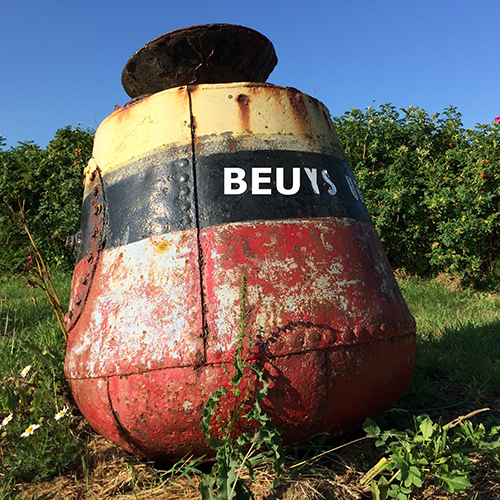Blog
Read, listen and watch how researchers and artists explore the effects of the Covid-19 pandemic on the arts. We will share texts, films, interviews and other forms created by artists, researchers and others here for you to get an idea how artists have changed their working practices as a response to Covid-19.
Hagira, or: Crone Cast on, at and with the beach
In October and November 2021, bird watchers, walkers, dogs and others happened to have the unique opportunity to observe crones at Dinas Dinlle Beach. Luckily, we had been able to calculate this rare constellation of hap a damwain prior to the sightings. Thus, passers-by (image 1) were accompanied by those who came specifically for the crones, equipped with their binoculars (image 2).
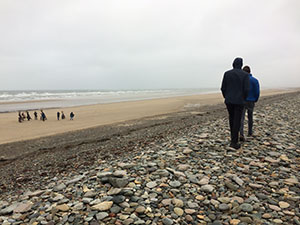
Image 1
Those who came knew to expect a magnificent performance, but who could have dreamt of what then happened: A gathering of human and more than human agency, conflicting first but then respecting each other and playing a multisensory symphony of multi-creatureliness: weather, crones, sand and water, seagulls, ducks, pebbles, dogs, pipits, humans, rocks.
Those who brought their binoculars quickly learnt that is was not about watching or listening a performance or listening but experiencing it – a performance for an audience beyond the human spectator.
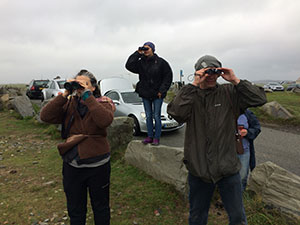
Image 2
Difficult to translate this into a video. Lindsey Colbourne used footage by Rufina Kaloyanova and herself editing this video: https://vimeo.com/645315157
NWK Triple Bill Buoy Blog 3 – Our golden Buoy is Little Buoy, Blog Dlewyrchol
We dragged him from the Boat Repairing Shed on Ynys Bach (Menai Bridge), he was in our tow through the mud, we carried him on our shoulders, opened doors into the future and literatures of the world... but only thanks to a colleague's eight-year-old boy, we learnt about the past life of our golden buoy: Golden he is now, but little he was then: Little Boy, was his codename once, acting as the atomic bomb dropped on Hiroshima on 6 August 1945. The homophonic reference shifted our embodied intersubjectivity: The traces our buoy left on our shoulders when pulling him through Treborth Tunnel, the back pain after carrying him to the Prince Madog … bodies giving metaphorical hints to bodies, the baggage of history.

The social vision we anticipated with our Buoys7000 project dissolved into further ambiguity, when that eight-year-old boy showed us the buoy his elderly brother once brought home - another objet trouvé. Different to our slim and long, but heavy-weighted golden – now renamed little – buoy (64kg), this buoy trouvé was rather light-weighted (6.4kg), less formed like a projectile but like an egg - uncannily resembling the atomic bomb Fat Man dropped over Nagasaki 9 August 1945. Messy contingency – or: Fluxus, Hap a Damwain - all constant companions on our metamorffosis journey. The agency of objects has been described in depth by Bruno Latour and developed further by theorists of the more than human, such as Jane Benett, Timothy Morton and of course Donna Haraway. For us, our golden buoy, now transformed into Little Boy performed his agency on us, making us listen to the encyclopaedic knowledge of the eight-year-old, his expertise on World War II and nuclear bombs, somewhere in the middle of Anglesey, home to now decommissioned Atomfa Wylfa (Wylfa nuclear power station). Little Boy‘s life – emerged during World War II – is a global matter, relevant to North Wales in 2021, as it was of course to Hiroshima in 1945 or the United States. It is even more relevant now that the UK has been pushing ambitious plans to use Atomfa Wylfa‘s site for a new nuclear power plant as an integral part of their carbon neutral strategy.

With our golden buoy having triggered unvaluable bliss in the course of our collaboration, we felt we owe him the respect not to disregard the stories the contingent encounter with Fat Man uncovered. Maybe this is the language they speak, these subjet trouvés‘ way of communicating with us (calling them objet trouvé seems somehow inappropriate)? Thus, NWK is now listening, harking, harking back with our ears, eyes, bowels, shoulders and backs awake for not missing out further stories. In Welsh, the verb "clywaf // clywed // clybod" is not only used to describe "to hear" or "to listen", but also to smell, feel and to taste - the sensations of our body which help us to survive, being connected to others - humans and more than humans. The Welsh language thus already has an understanding of communicating beyond the oral. Adding the preposition "ar" to "clywaf // clywed // clybod", Welsh allows you to express your commitment: You find it in your heart. Wir haben verstanden.

Since our encounter with the boys and buoys, we are further and further in their tows, passing by our blind spots and finding relation to that what was invisible once. One of them a shark painted by a friend and a rotting dogfish on top of a rock, reaching out of the high tide at Ynys Bach. A true cliff hanger for the next blog entry on the New Welsh Buoys. Yma, yn fuan.
NWK Triple Bill with Buoy Part II "Buoy meets Beuys"
This blog will look back on how we went forward after our recognition of the "golden bUoy" as an equal a member of NWK as its human members. An active member the "golden bUoy" is, and an agent. It engenders communicative situation with other members, it triggers behaviours of its human companions, and it generates meaning, transforms it, undermines it. The latter, this kind of semantic agency is what this blog is going to explore. NWK has been very active in the whole of 2021 for looking into the famous former Fluxus artist Joseph Beuys. World-wide but particularly in Germany, his 100th anniversary is celebrated with exhibitions, performances, films, happenings and other events. Fluxus is of utmost relevance for the aesthetic strategies of NWK. But NWK is not faithful to the original, does not aim for a precise and skilful mimesis of the historical Fluxus but rather playfully and curiously use, re-use and ab-use the Already Made for investigating its meaning, its appearance, its idea today – and also within the expanding vocabulary of NWK.
Our golden bUoy and Joseph Beuys share many things, they are a multitude, and they are not, the multitude bUoys find its echo in Beuys, the individual Beuy would find its echo in our golden bUoy. Homonym they are or are they not? With NWK acknowledging the golden bUoy as a companion, its members spot more and more buoys, deflated or floating, resting or beaconing – and we even bumped into a Beuys buoy (see image).
For us, these hap a damwains, verify our spirit, approve the playful connection of bUoy and Beuys. In 1982, Joseph Beuys created the land art project 7000 Oaks. His land art was a social sculpture as well, calling citizens of the German town Kassel (home of the Documenta) to get active for completing the land artwork and by doing that creating a social sculpture. The oak tree establishes the link to Celtic spirits as the basalt linked to geological time. For NWK, it was first a play of words to change 7000 Oaks to 7000 B(e)uoys but this metamorffosis soon revealed why the translocation of Beuys' 1982 Kassel project to 2021 Wales is more than the truthful materialisation of the Celtic connection of the original.
For 2021 Wales, it is less about geological time, but rather pelagic time. For 201 Wales, post-Brexit and mid-global warming it is about buoying up, about beacon buoys, about navigating in distress. The semantic and material metamorffosis into 7000 B(e)uoys does not only refer back but projects forwards: It allows to use the ethical and civic plea, inherent in Beuys' 7000 Oaks as a starting point to embark into crucial considerations about the future.
As a blog – different to an academic paper – allows expressions of bliss and zeal, NWK would like to close enthusiastically with the conclusion: Sometimes a more than human beacon is a faithful comrade of the contemporaries...
This became even more true with the new pathways emerging in front of us once we welcomed another buoy to NWK. But this is a different story to tell. Later, but soon, on this blog. Before we say farewell for now, let us give you an instruction to take along your everyday routes: Watch out - for buoys. And if you dare, please take a picture and send it to us for publishing it on our website: deuwalfreu@gmail.com.
NWK Triple Bill with Buoy Part I New forms of co-presence: Using media and more than human bodies
The multimedia performance „NWK-Triple Bill” explored the role of more-than-human bodies for the feature of bodily co-presence. Bodily co-presence is a term derived from social studies (Goffman) thus has only been applied to co-presence of human bodies, even by the most seminal applications in theatre or performance studies (Peter Brook, Erika Fischer-Lichte, Jerzy Grotowsky, Peggy Phelan).
But during the pandemic, co-presence of human bodies in shared space and time was not only limited but for some people, it turned into something conflicted. At the same time, this also made people more perceptible for other forms of bodily co-presence, most prominently hypervirtual telecopresence (Shanyang Zhao) such as the corporeal co-presence with or of more than human* bodies?
NWK has been working with more than human bodies, both for film and for stage performances, but rather by chance than on purpose:
During shooting of “Mother‘s Mask” (a family melodrama in post-brexit and mid-pandemic Britain), we found an old and deflated buoy of the size of approx. 4ft, an objet trouvé.

We started filming with it without really having a script, we simply came up with a series of sites where we thought the buoy would fit perfectly as an odd being to find. The buoy quickly turned into the protagonist of a story, yet to find, a story to evolve from the buoy’s bodily presence at various sights – the buoy developed agency. In the cause of the shooting the human actors had to engage physically with the buoy – a physical engagement rather demanding, as the buoy holds a heavy iron bar in its core. Pulling the buoy on a string or carrying it on your shoulders requires physical strength and stamina. Film is a moving picture, thus the buoy needed to be moved and be moving. We engage in physical work like this in everyday life, but the film and its narrative shifted the semiotics of this action: The buoy was not an everyday being, nor the places everyday sites for the buoy to be, thus new meaning and significance emerged. Consequently, the relationship between actors and buoy, by the physical engagement was beyond that of everyday life (see interview with Huw Jones in video documentation). Furthermore, when editing the footage, the buoy turned into the storyteller: his voice was his body, his words were the rules of gravitation, the forces of weight (when being pulled, carried, or lifted up). When thinking about showing the film at Metamorffosis Festival, we felt that this required further exploration. Showing this film would only allow mediatised embodiment of this new inter-being relationship, or mediatised representation of the agency of the buoy.
We started looking into ways to bring together the mediatised bodies of the film (the two human actors and the buoy) and their corporeal co-presence at the physical space of the film screening, meaning combining the film screening with a live performance.
The venue for the Metamorffosis-Festival event offered an opportunity to show the film in a theatre-like space: Bangor University’s Eric Sunderland Lecture Theatre is sort of a theatre black box, it has an auditorium seating and includes a stage-like platform in front of the white screen.
For the performance, we wanted an immediate physical interaction between buoy and actors that would referring to but also go beyond the action in the film**: All three entered the auditorium only a few minutes into the film running, making lots of noise for the audience to turn away from the screen. All three would slowly walk down the aisle, enter the stage, crossing the stage to then stop at the right-hand side of the stage. Both human bodies would place the buoy on the stage floor and start painting it slowly with gold coloured paint. Only a minute before the film ending, they would stop painting the buoy, leave the stage and auditorium and leaving the buoy on the stage - see video documentation: NWK-Triple Bill with Buoy - Metamorffosis.
Once, the theatre was illuminated, a third performer examined the body of the buoy to announce it as art and the world out of joint, calling for an investigative mind to bring light into what has just happened. By this, the scene was transformed into a crime scene with a body, addressed as “a body of work” by the CSI-Team entering the auditorium to investigate the crime.
The idea was not only to entertain and find a narrative to bridge the first film with the second film to show that evening, but to blur human and more than human bodies via rhetoric (usually, in a crime scene, the “body” referred to is a dead human body).
Though we cannot say at this point whether we achieved what we were aiming for with this performance from the audience point of view, we can say for sure that the performance transformed the relationship between the buoy and us once more. The buoy is now “our golden bUoy”, it became a full member of NWK with its own biography (though many episodes of his life remain yet to be uncovered). His bodily co-presence is not only a visual one, not only a symbolic one, but our bodies remember his body, his weight, the sound of his body when let pulled over the siliceous earth of Church Island, the muddy sand of Ynys Faelog or the tarmac of the Tregarth tunnel.
If we were to draw a conclusion, it would be that bodily co-presence is not limited to human bodies. Also, there comes a certain corporeal empathy between human and more than human bodies. This means, we can relate physically not only to other human bodies (feel their pain, return a smile). In 1886, Swiss art historian Heinrich Wölfflin, pioneered this thinking in his thesis Prolegomena zu einer Psychologie der Architektur (engl: Prolegomena for a Psychology of Architecture).
How to think and go forward from here
- to be continued - watch out this spot -
*The term more than human beings or for this blog: more than human bodies stems from eco-criticism and ecology studies but is more and more applied in other disciplines as well, particularly in the Arts & Humanities for thinking beyond the Anthropocene. More than human is often used to describe what we used to call “nature” but form an ethical standpoint which emphasizes that we exist in “a communicative, reciprocal relationship with nature” (Cianchi, John: Radical Environmentalism: Nature, Identity and More–than–Human Agency, 2015, p. 32) and engage in inter-species relationships (Haraway, Donna Jeanne: Staying with the Trouble: Making Kin in the Chthulucene. 2016). For this blog however, we also include non-living beings – thus beings we would not identify as nature or species – as more than human beings. For this inclusive thinking, object-oriented ontology is the seminal reference (e.g., Graham Harman).
** The film is consistently changing its title; at this stage its title is: Boy in the Elevator – playing with homophone boy and buoy. Part of the soundtrack of the film is a Spanish translation of the short story “The Man in the Elevator” written by former GDR playwright Heiner Müller which started to become relevant for the film, as we collaborated with the Mexican poet and musician Luis David Palacios, and artists in Bolivia. Heiner Müller´s text is a reckoning of revolutionary efforts and regimes of the Northern Hemisphere (incl. the Eastern Bloc).
We are delighted that NWK was invited to show the film as part of the Heiner Müller Special Müller gegen Müller. Widersprüche ohne Ende und am Ende das Ende at Theater Komplex in Chemnitz, Germany in September 2021.
Bibliography:
- Brook, Peter: The Empty Space: A Book About the Theatre: Deadly, Holy, Rough, Immediate. New York: 1996. Cianchi, John: Radical Environmentalism: Nature, Identity and More–than–Human Agency, 2015.
- Fischer-Lichte, Erika: The Transformative Power of Performance: A New Aesthetics. London and New York: 2008.
- Grotowski, Jerzy: Towards a Poor Theatre. Edited by Eugenio Barca. 1968. Reprinted. New York: 2002.
- Haraway, Donna Jeanne: Staying with the Trouble: Making Kin in the Chthulucene. 2016.
- Phelan, Peggy: “The Ontology of Performance: Representation Without Reproduction”. In: Unmarked: The Politics of Performance, 146-166. London and New York: 2005.
- Zhao, Shanyang: “Toward a Taxonomy of Copresence”. In: Presence, Vol. 12, No. 5, October 2003, pp. 445–455.
Kinaesthetic Explorations into More Than Human Intersubjectivity
This Vlog is an assemblage of experiences and ideas expressed in words, voice, drawings, colours and moving images. The start was made with the first of a series of expressions without words by Lindsey Colbourne. Let‘s continue with some voiced words by Samina Ali, lead, guide and facilitator of Metamorffosis Movement: https://youtu.be/sWNPiTwugsE
Metamorffosis Movement (MM) is an ongoing exploration into new forms of intersubjectivity or interobjectivity between human and more than human beings. Guided by Samina Ali, the group engages with various places, beings and becomings through movement. Different to exercises of meditation, phenomenology and agency of movement and embodiment places special emphasises on body-informed engagement with the world without neglecting cognitive processes or the involvement of the mind in sensual experience. However, kinaesthetic encounters into new forms of intersubjectivity are less triggered by a conceptual mapping of space, objects, time – but rather by embodied orientation towards the word. Scholars in sociology, phenomenology, psychology, and neuroscience have drawn on writings by Edmund Husserl and Maurice Merleau-Ponty for discussing this idea of individual and world relationship by embodiment further.
This has further been applied for current shifts in ecocriticism for including more than human beings – animate and inanimate – into conceptualising a new form of intersubjectivity. Samina, a trained psychotherapist, was also keen to explore kinaesthetic intersubjectivity in times of social isolation during a long-term lockdown as we experienced during the Covid-19 pandemic.
MM is of interests to questions of bodily co-presence, as its practice suggests new ways of engendering bodily co-presence for “live-events”, new forms which do not depend on human beings. During the pandemic, most people were challenged by the lack of experiences of intersubjectivity or the opportunity of personal growth by the ever complicated and conflicted interaction with other people. This does not only affect mental health but also artistic processes, for instance when a lack of challenges by ideas, behaviours or appearances of others triggers creative shifts. Thus, it is crucial for finding new forms of intersubjectivity for resilience in future times of deprived human sociality. Social interaction and intersubjectivity is only rarely without conflict, but most often a process of misunderstanding, vulnerability, divergences, lack of space and resources. However, negotiating distribution of resources and space, respecting divergences, considering vulnerability, and communicating to clarify and so much more is from which emerges society.
But even beyond pandemic situations, this issue arises, for instance when talking about the democracy of things or other ideas of a society of more than human beings. As we share space and resources not only among humans, as we misunderstand not only our neighbours, partners, or line managers, as it is not only us being vulnerable, but so are all more than human beings – the vision of a society of things thus suggests an expansion of our social awareness. Pandemic times like ours uncover the benefits that come with the responsibility of such a widened sense of society.
In the following, we will look back on a series of sessions of MM in preparation for the performance at the Metamorffosis Festival, including the performance itself. The group will continue its examination after the festival.
Each session began with exercises to raise everyone’s proprioceptive awareness, focusing on the own body, its position within the space – but not by stillness, but by movement. This also helped to warming up the body, stretching it, breathing off the immediate experiences of the day. The aim here is to enter our “wild” being. “Wild” does not necessarily mean an outgoing, furious, or crazy acting, but rather a state of being which is not concerned with our civilised routines, limited by our sense for shame, vulnerability and dictates of social protocols. This preparation exercise was followed by 15 to 20 minutes of guided individual exploration of the site and its more than human subjects, from insects to rivers, wind to jet skis. Each meeting was addressing a different challenge of the examination of intersubjectivity as intercorporality (video: https://youtu.be/xZ87A1fViIs). When gathering as group afterwards, everyone was invited (but not forced) to share their experiences. And finally, meetings completed with looking into ways to integrate the practice, the movement and experience into a dance performance for the festival. How and what kind of “vessel” to find for communicating the kinaesthetic intersubjectivity between humans and more than humans to an observing audience which might not be familiar with the concepts that informed the performance.
The first session was dedicated to finding individual ways into a state of sensual openness for engaging with more than human beings. These ways varied from participant to participant, for someone mimicking the other being was a way for relation and understanding, for others it was about focusing on the movement the own body performed when approximating the other being – for a river the movement is different than for a boulder or a tree –, and for others it was about positioning themselves within the shared space with other beings. Interestingly, some members forgot the presence of the other human members of the group during their interaction with the site and its beings. This, however, was not to be aiming for, as escapism from human interrelations is not the outcome we were hoping for, but rather an extension of interrelations with humans and with more than humans.
The second session focused on movement, site, and emotions. For supporting the examination of emotion, Samina shared emotions cards, and at different moments during the 15-20 minute exercise, members were asked to draw a new card and explore the emotion they found. The discussion afterwards revealed the impact of the site (Gloygfan Chwarel Dinorwig), its loaded history and its almost sublime nature turned out to be the vital force for embodying the respective emotion (video: https://youtu.be/xrTCN2bFl7A).
The third session addressed the challenge to acknowledge and experience both, bodily co-presence of human and more than human beings, and the communication of emotion. Thus, participants were called for not only engaging with the site and developing their own movement, but also to observe other members of the group for then copying their movement. It was to see whether movement can communicate feelings, but it was also about developing a kind of choreography for the performance. Repetition and patterns are not only crucial for communication, but also integral to all choreography. When repeating a movement that appears organically through improvisation, it honours the unknown into form, and this expression in repetition allows the mover to fully appreciate what this intersubjective experience is communicating through the body and its spontaneous movement qualities, through its continued focus, attention, and the allowing of its development.
The final sessions brought together the outcomes and experiences of the previous one in order to develop a performance score for the festival.
MM meetings took place a different sites, in order to vary the situation and environment of the explorations (https://youtu.be/cH27q67DihU), but also in order to site-scouting for the festival performance. After visiting the wood around Dolbadarn Castle at Llanberis, Gloygfan Chwarel Dinorwig, Cylch yr Orsedd at Porthaethwy and Paxton Cascase at Treborth Botanical Garden (Bangor). The latter was agreed to act as site for the Festival Performance, as it offered a dramatic scene though still balanced and not a landscape of sublime nature. A quiet waterfall amidst woodland, terraced to overgrown views onto the Menai Strait, it would also offer shelter from strong winds and rain, for both performers and audience. The chosen site also required everyone to move around, in order to watch the individual performers move around: it would not enable a panoramic gaze similar to a theatre “stage” – and trees, running or falling water, the fleeing sunbeams fallen through leaves and other members of the audience would block the view and set everything into an ongoing flow of movement, spectators and participants alike. Adding to this, in accordance with the performance – and supported by a short introduction by Samina Ali before the performance – more than human performers would come into view and proprioception.
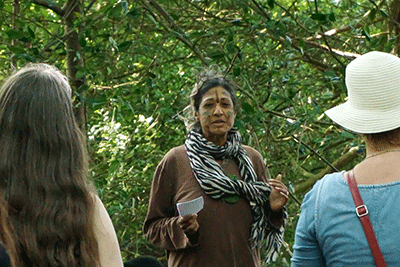
Image: Samina Ali introduces Metamorffosis Movement to Spectators.
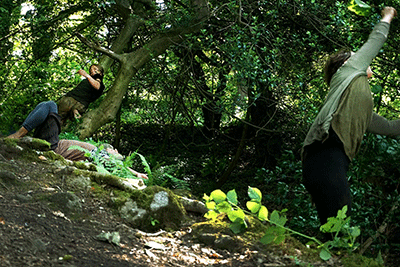
Image: Expanded intersubjectivity
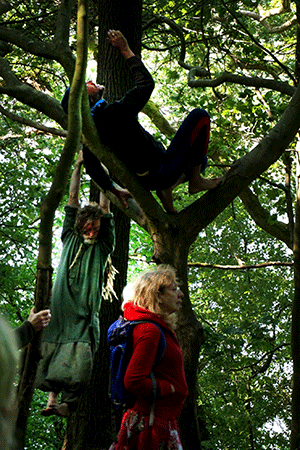
Image: Non-panoramic spectatorship
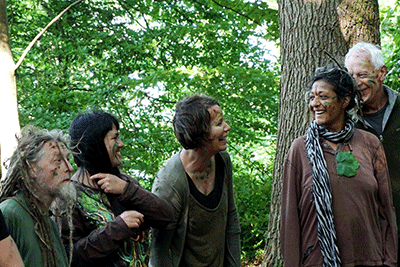
Image: New happy forms of a society of (more than) humans.
Thank you to Metamorffosis Movement:
Performers:
Lindsey Colbourne
Paul Haswell
Iona Morrison
Jodie Mellor
Ed Straw
Abi Sophie Beath
Samina Ali
Practises:
Irene Sofia Gonzales
Claire Lydia
Photography:
Huw Jones
Printing and Health & Safety contact:
Robert Annewandter
Researcher, filmer and photographer:
Sarah Pogoda
Inspirators (by Samina Ali):
Dr Beatrice Allegranti - for her feminist research, writing, film making, performing and Dance Movement Psychotherapy tutoring - where i learned about embodiment and so much more!
Mamu Lwntana - For his teachings as a member of the Kogi tribe who learned Spanish to spread out his teachings to local Colombians and travellers, and for his co-creation of Naturagente - where I learned to listen to nature and my surroundings intently, and with my whole being.
Fanny & Colin - for Co-creating Movement of Being - where i learned to truly love and be with what is, in acceptance and sitting in silence, in circles with others, and in movement.
Sue Rickards - for her facilitation of dance and movement in groups - where i learned to creatively move with what occurs in full presence and maximum expression!
If you are interested in some background reading into kinaesthetic intersubjectivity, we would suggest the following further reading:
- Allegranti, Beatrice: Embodied Performances: Sexuality, Gender, Bodies, 2011.
- Bråten, Stein: On being moved. From Mirror Neurons to Empathy. Amsterdam, Philadelphia: 2007.
- De Preester, Helena: From ego to alter ego: Husserl, Merleau-Ponty and a layered approach to intersubjectivity, in: Phenomenology and the Cognitive Sciences 7.1 (2008), pp. 133-142.
- Husserl, Edmund: Ideen zu einer reinen Phänomenologie und phänomenologischen Philosophie. 2. Buch. Phänomenologische Untersuchungen zur Konstitution. Den Haag: 1952.
- Merleau-Ponty, Maurice: Phenomenology of Perception, trans. C. Smith. London 1962.
Co-presence of sounds of any, no and everybody
Today‘s blog is a fingertip editing of earfull serendipity. The result aims to highlight omnipresence of bodies in our daily language in a co-presence of sounds of any-, no- and everybodies: https://youtu.be/QrV_ocFAiyo
Feeling through the Screens
by Anna Powell
‘I am a hand, a tool [...] six fingers with webs in between. Instead of fingernails I have petite, sharp, sweet-toothed little tongues with which I lick the world’.
(Jan Svankmajer’s diary)

Why are the senses limited to five, with sight given primacy? Can vision and sound create sensations of touch? Could touch produce thoughts as well as feelings? Is “viewing” a valid term for our experience of Jan and Eva Svankmajer’s Czech surrealist art and film? How might their work with touch have post-lockdown relevance to art practice and more widely?
Metamorffosis arts festival was our creative response to restrictions. My own opening input was Vision and Touch in the Svankmajers’ Surrealism, an illustrated talk. The Svankmajer project used claymation, film, art, puppetry, games and critique to transform bodies. With metamorphosis as core aim, their group experiments with touch and their samizdat circulation (1974-1983) were mobilised by the political censorship they subverted. As well as ‘hands-on’ artisanal making, they theorised Tactilism. The blocking of their films led to experimental workshops drawing on dreams, erotica and childhood memories. The tactile imagination develops from transfiguring this most crucial sense.
So what was my own embodied experience as the first speaker? My audience in the dark, quiet auditorium included friends physically absent during lockdown, their familiar faces masks for protection. Social distancing stymied bodily contact and limited dialogue. Yet, I felt their attentive and supportive presence still there with me. I was anxious, unsure how to respond to a restricted context. A large, solid IT desk, thick perspex screen and microphone restricted or distorted my own bodily expression. When giving talks, I’m often more mobile and use my own voice. I’m deaf and had just emerged from months of reliance on the zoom screen for captions (the stuff of Surrealist poetry!) lip-reading and deciphering facial and bodily language. Now, my partner was a helpful scribe.
The Svankmajers’ work extends sensory limitations, blurring the boundaries of human/non-human, subject/object and restoring magical functions to things. For them, objects have ‘some kind of inner life’ mobilised by human touch. The ‘interpretative play’ of their method aims to restore tactile memory, extending imagination and reconnecting to the world. In the face of Stalinism, they assert an ‘absolute departure’ from rigid ideology and consumerism, therapeutic for both individuals and society.
The talk included a screening of The Fall of the House of Usher (1980) a ‘classic’ literary adaptation made to elude the censors https://www.youtube.com/watch?v=AecpTfxCQvA
Like Poe’s writing, Svankmajer’s animation expresses psychic strain on the senses via a sinister house with its own uncanny life. Stop-motion claymation replaces character identification by affect. Our eyes and ears do the touching, penetrating the screen by tactile imagination. Gilles Deleuze’s term tactisign ‘a touching specific to the gaze’ is a helpful tool to think the intensive sensation of touch when motor functions are suspended. (Cinema 2, p. 12) Finally, I suggested experimental games to isolate and intensify touch and vision via synaesthesia, as one sense evokes others. Pre-Covid, I used them with artists to stimulate new work, but now invited people to experiment privately and safely in social bubbles.
The Svankmajers’ art can still inspire contemporary responses to physical and societal restrictions. Defying utilitarianism, their project validates our physical and imaginative awareness of ‘the tactile world within and outside us’. Tactilism encourages us to re-experience, express and reflect on our sensory capacities and their damming up. After a productive Q/A session, hands at last made contact to clap. Tonight, I felt that we had shared the touching of-and through-screens, with art working as catalyst for a communal energy.

https://thedissolve.com/news/1988-short-cuts-dimensions-of-dialogue-a-classic-stop-m/
Blog The Poet’s Feet
Poetry and the body have always been connected. A plethora of poems focus on bodies and body parts. Poets use their body for writing, e.g., their hand to hold a pen. They sit while writing or erect their bodies upright for a standing desk... A poem embodies a poet, poets embody their poetry, writing it, reciting it, taking poetry off the page.
We might refer to poems as a body of work, or enjoy the body of a poem – how words are arranged on the page, how the shape of typography is consciously used (e.g. in concrete poetry), poems are words in co-presence with other words on a specific page, in a specific book... poems are sounds in co-presence with other specific sounds in space and time..
However, there is a sensual difference between reading poetry from a book, at home, by oneself – or experiencing poetry as a performance, in a non-private space, together with others, the words and sounds performed aloud by poets (in person or recorded). Of course, there are multiple variations possible between and beyond these two modes of poetry.
A poetry performance brings together more than human and human bodies: words, sounds, poets, audiences, chairs, books, pages and other. That was also the case for our poetry performances at the Metamorffosis Festival. Each of them very different to the other – and all very different to pre-pandemic times: Some outdoors, some indoors, some in the dark, some in movement, some in bright light, some participatory – but each enabling us to experience variants of co-presence with viral words, pandemic sounds, infectious images and breathing bodies.
Revisiting our footage from one of the Poetry Performances at Awen 33 RitUal ExhiBition & EclogUe?, we found the camera to accidentally film only the poet‘s feet. While the Covid-19 pandemic has caused us to focus our gazes on covered (and uncovered) faces – be it in the streets or be it in online meetings –, the camera caught where Rhys Trimble’s poetry is happening: Often most distanced from the covered and uncovered mouth, feet and toes embody poetry no less:
https://www.youtube.com/watch?v=wc45OxlfBok
For our next online meeting, we might want to reconsider the positioning of the webcam and take of our shoes and socks...
Hag Haf Ha Ha – Canol Haf ar y Stryd Fawr (Midsummer on High Street)
For this blog Crone Cast is sharing some edited footage from their journey into Bangor High Street on June 22th 2021. They will share more thoughts in various form with us in the weeks to come. This is not the beginning of Crone Cast and Hag Haf Ha Ha, as all becoming has beginnings beyond numbers. Hag Haf Ha Ha is an exploration beyond the familiar, underneath the commercial layers of reality and twixt imagination triggering minimal shifts in dispositifs of bodily co-presence.
This ffilm bach gives a notion of this.
As you can see in this second ffilm bach more than human beings are included in their performances.
The third ffilm bach to share for this first Hag Haf Ha Ha blog entry indicates their vision of a new community across species and things. In a time where our High Streets vanish, Hag Haf Ha Ha uncovers the vivid potentiality so far restrained by commercial hegemony in our public sphere. Magic is still to be found with these beings barred from our sights and sites of capitalist normativity.
Text by: Sarah Pogoda; Videos by Lisa Hudson
Journey with Rivers
Ioanna “Daphne” Giannoulatou and Stephanie Januchowski-Hartley brought their creative workshop Journey with Rivers to Treborth Botanical Garden. They are members of FIRE – Freshwater Interdisciplinary Research and Engagement – Lab at Swansea University and have been delivering similar activities virtually as well as in Wales, indoor and outdoor. Using different sites, either in person or virtually, makes each workshop a unique experience, as sites inform how participants feel and move, what they hear and see.
We could not see the Afon Menai from our site at Treborth Botanical Gardens but we were adjacent to two small ponds (with newts!). Therefore, the journey with rivers would be an imaginative one, with no corporeal co-presence of running waters. Daphne and Stephanie have designed the activities for the day with this in mind.
Maybe because it was a sunny and hot day, Daphne and Stephanie decided to situate the workshop at the Two Dragons Garden which offered benches for participants to sit, and refreshing shade thanks to tall plants. Also, the bright sunlight on the grass in the background and the reeds in the foreground evoke a river-bank-ish impression.

Furthermore, the Two Dragons Garden offers an enclosed space within the total 18 hectares of Treborth Garden. To some degree, the tall trees engender a feeling of an enclosed space with a roof. This enclosed space has a visible gateway and a short, pebbled path leading into it. Thus, the Two Dragons Garden allowed a clearly marked entering a separate space for the event to take place: For joining the Journey with Rivers participants went on a short liminal journey experienced by moving our bodies from the open outside space of Treborth grounds through the circular gate into the enclosed inside (the outside entered mildly filtered as a drift of wind, noise and sun).
Following social habits, the participants set around the workshop leaders, and waited for them to start talking – a clear division between audience and performers. However, as liminal as is the enclosed space of the Two Dragons Garden, is this relationship between audience and performers. Right from the start, Daphne and Stephanie invited the audience to become participants. Also, throughout the workshop Daphne and Stephanie took pictures – thus the camera was present as an audience apparatus as well. The workshop was structured by several interactive sets which guided participants to embody the announced Journey with Rivers:
- creating a visual haiku;
- creating a Haiku on their relationship with rivers;
- reading the Haiku aloud to all participants (video: https://youtu.be/Je8PoH0nFlM );
- bringing together all creative work for a collaborative performance to be performed for Ioanna and Stephanie with costumes prepared by participants.

For all activities, we were provided props – notably those of a fishier-kind – and were also encouraged to interact with the surrounding environment. Participants explored the Two Dragons Garden, the small pond newts (excuse the pun!) to it, and the group of oak trees close by. The instructions for creating haikus and collaborative performance invited for exploring the site by moving through it, finding relations to trees, plants, newts, damselflies, and other more than human beings and how they might embody or resonate the participants’ relationships to rivers. The set up and activities creatively confused the botanical space and transformed it into an art studio, a gallery, a river bottom, botanical museum, or a lieu memoire, when certain entities, words or sounds evoked memories.

The workshop design and the actual site engendered a fluid space within which embodiments changed to gaze, gaze changed to embodiment, changed to sound or other. Audience changed to agents, changed to performers, changed to audience, the site changed to a stage, changed to an agent, changed to a performer. This shifting of roles, agency and embodiment between participants, performers and site were made visible by the theatrical character of the Two Dragons Garden. These processes of relationships (which could be seen as a metamorphosis) involved human and more than human beings. The experience of bodily co-presence of this live event emerged from the playful interconnectedness of embodiment by the human participants, the workshop leaders and the more than human participants (e.g. the props, the words, the birds, the wind, the sun, the site).
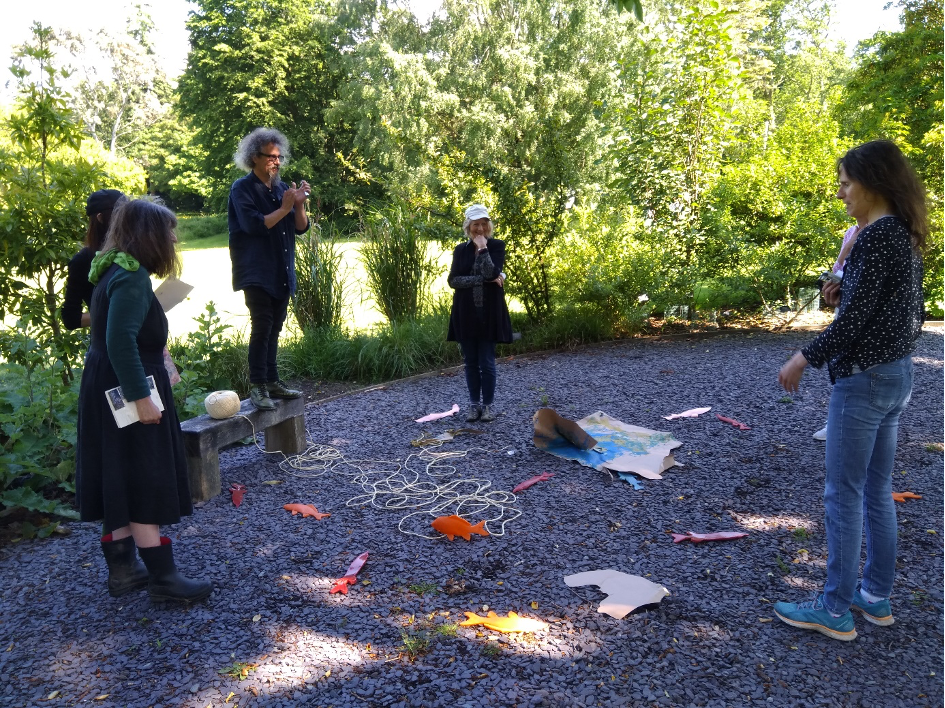
Swellies ... Afon Menai, Afon Rhein ... choke ... Afon Ogwen, Afon Beuys ... poison ... Afon Elbe, Afon Schlingensief, Afon Yoko Ono ... trap, kill, destroy ... Afon Main, Afon Vostell, Afon Forelle, Afon Gad, Afon Wupper ... Becoming Swellies... Fluxus.
The outcome was an aesthetic experience (see: https://youtu.be/FGS8QKOuke0 ).
There is more to say about the impact of the site on the creative inputs, but this is not the blog to do so.
Introduction to Blog Section
This blog is documenting ongoing thinking in practice concerning the core questions of the research project. These questions focus on bodily co-presence and its role in the experience of live events:
According to performance studies scholarship (Fischer-Lichte: 2008; Mersch: 2002), bodily co-presence is constitutive to live events, whereas stage, make-up, costumes, music, text and other features usually associated with performance arts events are expendable (Grotowski: 1986). The restrictions imposed by Covid-19 are therefore not only challenging the live arts event economically – with events cancelled and funding on hold – but also ontologically. Furthermore, most intrinsic benefits commonly ascribed to live arts events – enrichment of people’s lives, enabling social interaction among community members, experiencing a sense of community – are linked to bodily co-presence.
Thus, has Covid-19 killed the live event? Many in the Creative Industries fear so (e.g. Biado: 2020). An alternative view, however, could be: ‘Long live the live event!’. The Metamorffosis Festival has shown that the arts responded to the challenges of Covid-19 creatively. This website, and this blog, will explore in text, image, audio, and video, some of the issues raised above.
With a focus on new forms of bodily co-presence, the blog will not only engage with various bodies (human and more than human), but also with various spaces (or: sites) and time. This is due to the fact that usually, bodily co-presence describes the fact that at a live event, performers and audience are physically present in a shared space at the same time. These are the factors to explore in this blog as foci to find new forms of being co-present. Bodies take space and identify place, bodies are situated in time. All three are interrelated and in this interrelation shape the experience of bodily co-presence.
The blog is meant to be a creative and open space for proposing and exchanging ideas in various registers, styles, and media. It is not only aiming for an academic audience but is seeking for being an informing and enjoyable read for arts practitioners, stakeholders, and the wider public, too. You will encounter references to scholarship, but also to existing creative practice and other – maybe odd – references that are inspirational to the issues addressed.
Please enjoy reading, watching and listening. Please contact Sarah for questions, comments and other: s.pogoda@bangor.ac.uk.

